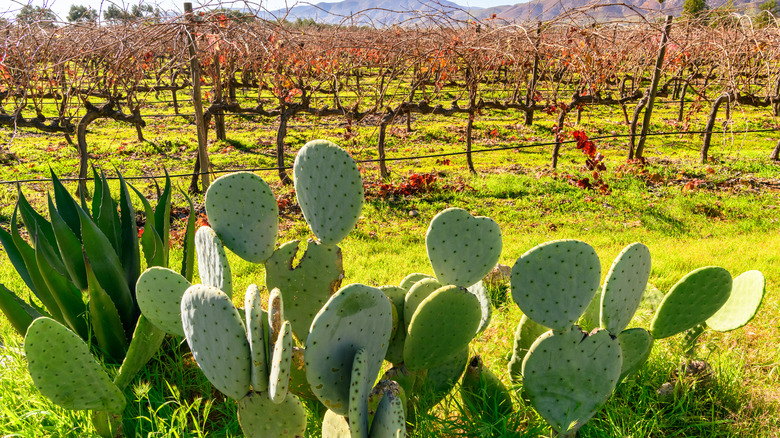Why Baja Wines Have A Meaty Aroma
Baja is hardly considered a major player in terms of wine-producing regions of the world. Located in the northwestern corner of Mexico, Baja is a narrow strip of land surrounded by the Pacific Ocean in the west and the Gulf of California in the east. About 90% of the wine produced in Mexico happens here, in the Valle de Guadalupe, per Discover Baja. VinePair suggests a possible reason Mexico has not established itself as a powerhouse wine producer is that the country has never claimed a signature grape. For example, Australia is known for its Shiraz grapes, Napa for its Cabernet Sauvignon, and Germany for its Riesling. Baja, on the other hand, has very few rules to regulate their wine production, so they successfully grow a wide variety of grapes including Pinot Noir and Nebbiolo.
But don't expect your Mexican Nebbiolo to taste like the one you've had from Piedmont, Italy. Sure, because Nebbiolo wines are generally considered bold and rich, you'll probably get the familiar leather and rose aromas and flavors that are associated with the wines but don't be surprised if you detect meat on the nose. Wine Academy explains that terroir, or the conditions in which a grape is grown, has everything to do with how a wine smells and tastes, which is why the same type of wine can be vastly different around the world. When it comes to Baja, there are a couple of elements that may account for its wine's carnivorous aromas.
Temperature and water
The Cheeky Vino explains that when a wine has a meaty aroma, it will smell "fleshy." It may sound off-putting but VinePair reassures the meaty aroma coming from your glass is actually an indicator of good quality and primarily a sign of big, bold red wines.
Vice explains that most of the wines produced in Baja are, indeed, robust, which is mainly to do with the region's warm temperature, which can spike to 100 degrees Fahrenheit in the summer. The Nebbiolo grape, for example, likes warm temperatures, but in Italy and northern California, Nebbiolo grapes get a break from the heat in the form of cool fog that rolls over the vineyards in the morning. In Baja, this does not happen, so grapes are constantly developing their flavor, becoming "meatier," so to speak.
The water sourcing in Baja's vineyards also undoubtedly affects their wines. According to VinePair, the area gets very low annual rainfall, and because water is scarce all over the region, vineyards are not allowed to irrigate with the main water supply. As a result, wine growers can dig to reach the water table (which is high in salinity and, thus, needs to be done carefully), or use reclaimed water. In other words, the grapes in Baja have to work hard for themselves, but that's part of what makes a great, meaty wine.

